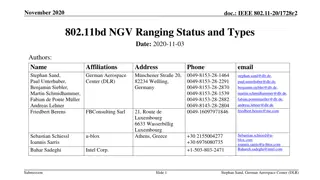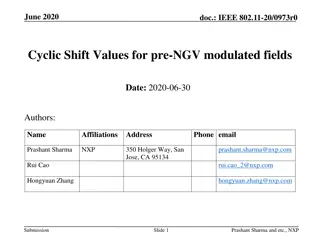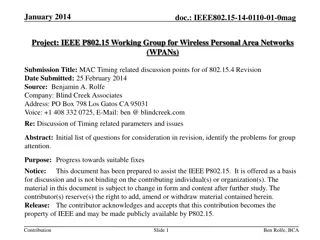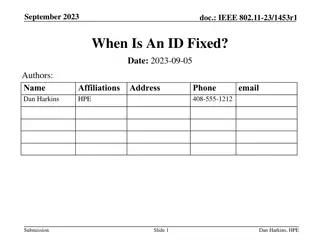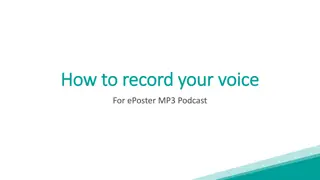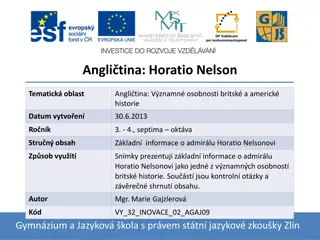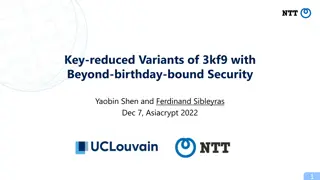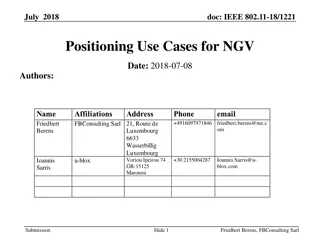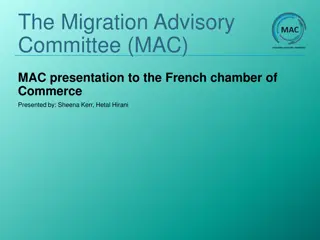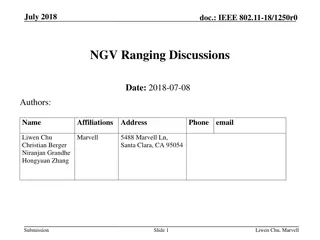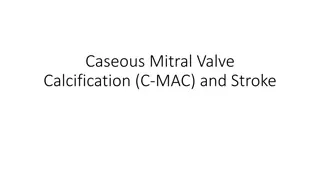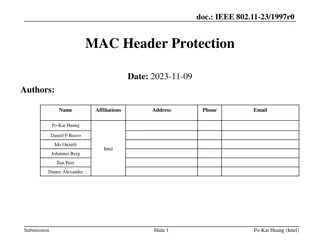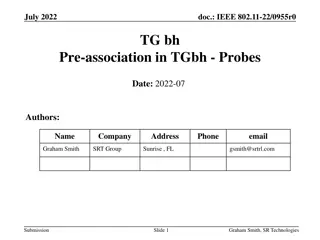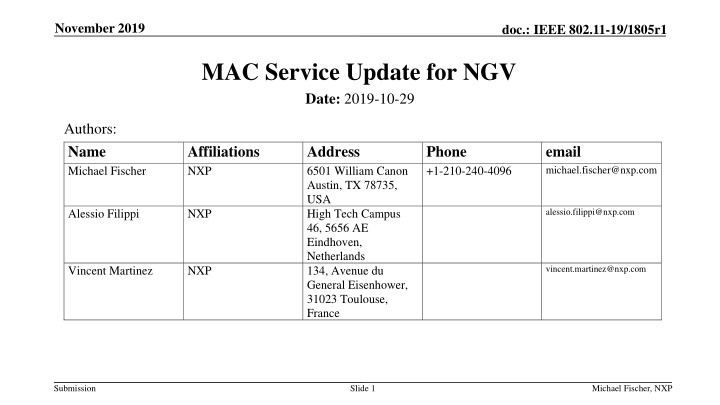
IEEE 802.11-19/1805r1 MAC Service Update for NGV
Explore the November 2019 document on IEEE 802.11-19/1805r1 MAC Service Update for NGV. The document delves into the enhancements and extensions required by higher protocol layers, focusing on MAC facilities and functions needed for rapidly changing radio environments. Discover the unexposed MAC facilities crucial for vehicular protocols and the functions added by TGbd requiring further SAP exposure. Gain insights into the comparison of MAC_SAP as of 2016 IEEE 802.11-2016.
Download Presentation

Please find below an Image/Link to download the presentation.
The content on the website is provided AS IS for your information and personal use only. It may not be sold, licensed, or shared on other websites without obtaining consent from the author. If you encounter any issues during the download, it is possible that the publisher has removed the file from their server.
You are allowed to download the files provided on this website for personal or commercial use, subject to the condition that they are used lawfully. All files are the property of their respective owners.
The content on the website is provided AS IS for your information and personal use only. It may not be sold, licensed, or shared on other websites without obtaining consent from the author.
E N D
Presentation Transcript
November 2019 doc.: IEEE 802.11-19/1805r1 MAC Service Update for NGV Date: 2019-10-29 Authors: Name Michael Fischer Affiliations NXP Address 6501 William Canon Austin, TX 78735, USA High Tech Campus 46, 5656 AE Eindhoven, Netherlands 134, Avenue du General Eisenhower, 31023 Toulouse, France Phone +1-210-240-4096 email michael.fischer@nxp.com alessio.filippi@nxp.com Alessio Filippi NXP vincent.martinez@nxp.com Vincent Martinez NXP Submission Slide 1 Michael Fischer, NXP
November 2019 doc.: IEEE 802.11-19/1805r1 Abstract The layers of the protocol stacks which operate just above the 802.11 MAC, and are intended for use in rapidly-changing radio environments, including IEEE 1609.4 and comparable standards for other regional regulatory domains, require access to facilities that are not exposed at either the 802.11 MAC_SAP or the MLME_SAP. Therefore, it is appropriate for TGbd to define extensions to 802.11 MAC services (limited to use when dot11OCBActivated = TRUE) that expose the functions needed by these higher layer vehicular protocols. Submission Slide 2 Michael Fischer, NXP
November 2019 doc.: IEEE 802.11-19/1805r1 Overview Unexposed MAC facilities needed by higher protocol layers today include: Direct selection of many items in the TXVECTOR, including channel, data rate/MCS, and transmit power level, on a per-MSDU basis The ability to specify an expiry time which is the value of the TSF timer at which the MSDU is no longer valid and may be purged by the 802.11 MAC before transmission The ability to change the station s MAC address without resetting the entire MAC Reporting of Channel Busy Percentage Additional MAC facilities needed with 802.11bd: Control of the capabilities indicated by the NGV capability indication mechanism Reporting of capabilities indicated by other stations whose transmission are received Access to far more TXVECTOR parameters as well as reporting of RXVECTOR parameters from receptions that are reported upward Submission Slide 3 Michael Fischer, NXP
November 2019 doc.: IEEE 802.11-19/1805r1 Functions Added by TGbd Needing SAP Exposure The enhanced MAC and PHY functionality being added by TGbd are going to require further extension Selection of MAC enhancements provided by TGbd on a per-MSDU basis Selection of PHY enhancements provided by TGbd on a per-MSDU basis Reporting of optional facilities used to convey received MSDUs Reporting of station capabilities, both for received MSDUs and for stations within RF range whose transmissions are detected but not addressed for reception at this station Submission Slide 4 Michael Fischer, NXP
November 2019 doc.: IEEE 802.11-19/1805r1 Comparison of the MAC_SAP as of 2016 IEEE 802.11-2016 MA-UNITDATA.request (source address, destination address, routing information, data, priority, service class) MA-UNITDATA.indication (source address, destination address, routing information, data, reception status, priority, service class) MA-UNITDATA-STATUS.indication (source address, destination address, transmission status, provided priority, provided service class) IEEE 1609.4-2016 MA-UNITDATAX.request (source address, destination address, routing information, data, priority, service class, Channel Identifier, Time Slot, Data Rate, TxPwr_Level, ExpiryTime) MA-UNITDATA.indication not specified, the 802.11 primitive is used MA-UNITDATAX-STATUS.indication (source address, destination address, transmission status, provided priority, provided service class) Submission Slide 5 Michael Fischer, NXP
November 2019 doc.: IEEE 802.11-19/1805r1 Comparison of the MLME_SAP as of 2016 IEEE 802.11-2016 The subset of 802.11 MLME primitives explicitly listed in 1609.4 are: MLME-GET MLME-SET MLME-TIMING_ADVERTISEMENT MLME-GETTSFTIME IEEE 1609.4-2016 MLME extension primitives specified in 1609.4: MLMEX-TA / MLMEX-TAEND MLMEX-CHSTART / MLMEX-CHEND MLMEX-REGISTERTXPROFILE / MLMEX- DELETETXPROFILE MLMEX-CANCELTX MLMEX-GETUTCTIME MLMEX-AddressChange MLMEX-SendPrimitive The primitives in bold require support within the 802.11 MAC (for dot11OCBActivated = TRUE) Submission Slide 6 Michael Fischer, NXP
November 2019 doc.: IEEE 802.11-19/1805r1 Extending the MAC Data Service Primitives Add an NGV-specific parameter to each of the MAC Data Service primitives: MA-UNITDATA.request (source address, destination address, routing information, data, priority, service class, radio environment request vector) MA-UNITDATA.indication (source address, destination address, routing information, data, reception status, priority, service class, radio environment status vector) MA-UNITDATA-STATUS.indication (source address, destination address, transmission status, provided priority, provided service class, radio environment status vector) A radio environment {request/status} vector parameter shall be present when dot11OCBActivated is TRUE and absent otherwise. By defining the new parameter as a vector, and describing the elements of these vectors in separate sub-clauses, the editorial impact on existing clause 5 text is minimized. Submission Slide 7 Fischer - Filippi - Martinez, NXP
November 2019 doc.: IEEE 802.11-19/1805r1 Radio Environment Request Vector Contents The Radio Environment Request Vector allows the higher layers to control the format, encoding, and MPDU handling for the 802.11bd transmission The elements of the Radio Environment Request Vector include: Transmission format (legacy/NGV, data rate/MCS, etc.) Coding and spatial stream alternatives (LDPC, number of streams, etc.) Aggregation alternatives (if any) Number of repetitions PHY alternatives (band, channel, width, transmit power level, etc.) Expiry time (time after which this MSDU is discarded if not transmitted) whatever else needs to be controlled within the NGV MAC and PHY functionality) A value that permits selection within the MAC shall be defined for each element Submission Slide 8 Fischer - Filippi - Martinez, NXP
November 2019 doc.: IEEE 802.11-19/1805r1 Radio Environment Status Vector Contents The Radio Environment Status Vector provides to the higher layers status about the current radio environment and the most recent 802.11bd reception The elements of the Radio Environment Status Vector include: Transmission format used (legacy/NGV, data rate/MCS, etc.) Coding and spatial stream alternatives used (LDPC, etc.) PHY alternatives used (band, channel, width, etc.) Submission Slide 9 Fischer - Filippi - Martinez, NXP
November 2019 doc.: IEEE 802.11-19/1805r1 Reporting of Radio Environment Characteristics The characteristics of the radio environment are reported on a periodic basis, independent of receptions of MSDUs, so need to be reported separately. This can be done using a new service primitive MA-RADIOENVIRONMENT.indication (Channel Busy Percentage, Capability Percentage, Station Count) Channel Busy Percentage as already defined in IEEE 1609 Capability Percentage percentage of stations indicating NGV capability Full definition (therein called TechPercentage ) appears in 11-19/0783 Station Count number of individual stations (individual MAC addresses) detected during most recent measurement period of Channel Busy Percentage and Capability Percentage Submission Slide 10 Michael Fischer, NXP
November 2019 doc.: IEEE 802.11-19/1805r1 MLME SAP Extension IEEE 1609.4 includes a set of primitives extending the MLME_SAP. These appear as MLMEX-primitives in Clause 7 of IEEE 1609.4-2016 The MLME_SAP in 802.11bd should include a request/confirm primitive pair that corresponds to MLMEX-AddressChange A primitive for this purpose is needed by other 802.11 amendments and is being proposed to TGmd. If that proposal is adopted, no further work on this primitive will be needed in TGbd. The MLME_SAP in 802.11bd should include a request/confirm primitive pair that corresponds to MLMEX-CancelTX The function of this primitive is to cancel transmission of MSDUs, within a specified access category, that have already been submitted for transmission, within, but are not yet contending for transmission. It is not necessary to expunge MPDUs at the head of the queue and already involved in EDCA contention. It does not appear that other MLME_SAP extensions are required, but further consideration, and discussions with IEEE 1609 (and other, outside groups) is appropriate. Submission Slide 11 Fischer - Filippi - Martinez, NXP
November 2019 doc.: IEEE 802.11-19/1805r1 Additional Attributes in 802.11bd MIB Some of the NGV-specific parameter values are static, and can be managed as MIB attributes rather than service primitive parameters at the MAC or MLME SAPs. These include: NGV activation (the NGV equivalent of dot11OCBActivated) NGV capabilities (to be indicated in transmissions from this station) NGV bands supported Measurement interval for ChannelBusyPercentage (default value 100ms) ChannelBusyPercentage smoothing parameters (to accommodate CBR/CBP differences) Measurement interval for CapabilityPercentage (default value 1000ms) Interval between repetitions (for use when number of repetitions > 0) Submission Slide 12 Fischer - Filippi - Martinez, NXP
June 2019 doc.: IEEE 802.11-19/1805r1 Straw Poll Do you agree to add the following text into Section 3.2 of SFD? The MAC service interface (MAC_SAP and MLME_SAP) shall be extended to provide higher layers with the ability to control NGV transmissions and receive status regarding NGV receptions and the radio environment when operating with dot11OCBActivated = TRUE). Y: N: A: Submission Slide 13 Michael Fischer, NXP
June 2019 doc.: IEEE 802.11-19/1805r1 Motion To direct the TG editor to incorporate the proposed normative text from submission 11/19-1982r0 into the TGbd draft. Y: N: A: Submission Slide 14 Michael Fischer, NXP



